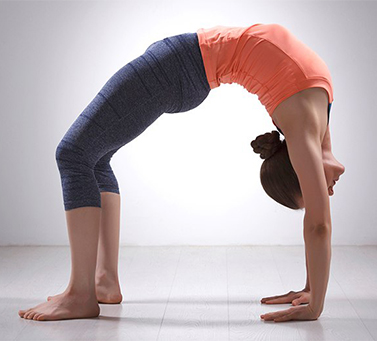
Setu Bandhasana, or bridge pose, is a gentle backbend that is excellent for opening the rib cage, enhancing respiration, and restoring healthy posture. It’s also great for opening the muscles of the upper back & neck, making it a perfect preparatory pose for shoulderstand & other inversions. Other benefits of bridge include:
Promotes openness in the shoulder-girdle & upper chest as well as greater circulation to region of thyroid & parathyroid glands.
Builds strength in the hamstrings, gluteal muscles & lower back
Provides many of the benefits of inversions in a way that is both safe & gentle
How It’s Done…
Lie on your back with legs bent & soles of the feet on the floor. Ideally, your feet should be placed so that the legs are parallel, a straight line from the top of the hip-bone to the knees & down to the soles — this will give the most effective engagement to the back of the legs & increase the benefits of your pose.
Take a moment to slide the shoulders down toward the waist — this will help open the back of the neck & shoulders, allowing you to press up more fully.
Engage the legs as you press the hips toward the ceiling. Check the legs & feet to see if they are still parallel — it’s natural for the knees to unconsciously release a bit out to the sides, in which case you may wish to shift them back.
In addition to pressing the pelvis toward the ceiling, think about pressing the chest toward the chin — this will deepen the stretch to the back on the neck, increase engagement in the legs, and stimulate the thyroid gland & lymphatic system. In fact, the name of the pose refers to this — setu bandhasana means “building the lock,” and it refers to jalandara bandha in which the chin is pressed toward the chest.
To deepen the stretch, you can bring the hands together behind the back, interlace the fingers & extend the arms toward the feet, gently rocking the body so the shoulder-blades can move toward one another, opening the chest from side to side.
Alternatively, some practitioners prefer to take hold of the ankles — this helps to draw the chest more fully toward the chin. See what version fits you best, and also consider checking in now & then with each version — you might find an approach becomes more comfortable as your body opens.
You can use the breath to expand the rib cage on the inhale, amplifying the stretch, and gently contract the abdomen on the exhale, giving a massage to the organs of the abdomen and greatly assisting both digestion & peristalsis.
Finally, setu bandhasana is an active pose, which means you want to feel that that muscles of the legs are consciously engaged. Correspondingly, when you feel that the lift is beginning to fade, allow yourself to slowly& gently release down.
Again, because of the stretch it provides for the neck & shoulders, bridge is a great preparation for shoulderstand, but it can also be enjoyed any time opening of the shoulder-girdle would feel beneficial, as well as any time you’d benefit from a backbend that is more gentle & relaxed.
www.oldtownyoga.com/yoga-basics-bridge-pose-or-setu-bandhasana/